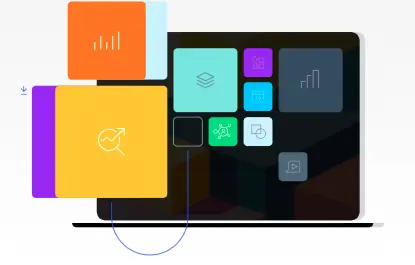How low-code/no-code integrations solve the biggest problems in marketing for brands
Harmonize your data, understand your customers, and act in real-time with low-code/no-code integrations.

Greg Cypes

In recent years leading brands have leveraged technology to change their relationship with customers from a series of transactional touchpoints to an expansive journey across channels, devices, applications and more. The result has been an explosion of customer data and with it more opportunities to deliver speed and convenience to customers as well as predictability and scale to business.
To manage an incredible amount of valuable data, the typical enterprise marketing department has about 120 marketing technologies in operation. However, recent industry reports indicate that many brands still struggle with integrating technology such that the whole becomes greater than the sum of its parts.
Today, marketers know all too well the sprawling landscape of digital tools due to the difficulty of getting these tools to work together beyond their specialized touchpoints and toward the whole customer journey.
According to Gartner’s 2020 Marketing Data and Analytics Survey, “[T]eams currently spend too much time on low-value tasks, such as data integration and formatting, ad hoc queries and requests, and generating reports and dashboards.” Additionally, the time spent on data management, integration, and data formatting has increased by 12% since 2018.
While integration has continued to mean writing custom code to complete low-value tasks, this trend has continued alongside significant investments in hiring and technology.
There’s never been a better time to find a job as a data scientist and new technologies such as the customer data platform (CDP) have been on the rise. If integrating is only the first step in solving the customer data problem, why is it also consistently rated the most time-consuming?
Marketer-friendly integrations are no-code/low-code
At Optimizely, we believe marketers can reach their full potential and better serve their customers with an adaptable customer data management solution that supports the full customer journey. Beyond integrating and storing data, brands need to leverage data to create compelling digital experiences for their customers and technology should empower them to do so.
“A CDP falls short if all it does is store data; a CDP needs to be able to assist a marketer with recommendations and predictions, making activation easy and reducing time to value,” said Justin Anovick, CPO of Optimizely. Integrating is just the first step, and until now, it’s been very difficult, almost impossible, for marketers to do it alone.
Our CDP, Optimizely Data Platform (ODP), offers a no-code integration solution that makes managing your data a snap. Instead of writing custom code, point and click to integrate. ODP will handle identity resolution, or the “stitching together” of the digital experience into a 360-degree view of the customer. The unified view provides marketers the customer context they need to participate in the customer journey the way customers expect.
Optimizely’s no-code connectors work both ways to integrate and activate data in real-time, in any connected channel. Through no-code/low-code integrations, marketers finally have the orchestration layer to act upon their customer data and insights.
The speed and ease of completion offered by low-code/no-code integrations also provide business leaders advantages when evaluating whether to upgrade or innovate their marketing technology stack.
Low-code/no-code integrations enable marketers to compose capabilities for right-fit solutions
Advantages of no-code and low-code integrations
- Adaptability: Marketers can quickly plug-and-play capabilities to ingest new data sources, activate new channels, and respond to fast-moving changes in the market
- Speedier time-to-value: the ease of use and low technical requirements enable marketers to proceed quickly with new connections without spending limited resources on getting started or maintaining integrations
- Lower risk: one-click connectors mean less can go wrong, no more writing custom code, manual uploads, or crossing your fingers. They’re managed by Optimizely in the App Marketplace so your team doesn’t have to maintain custom builds.
- Composable architecture: with a modular approach, marketers have more control over their technology stack, and ultimately the technology can more seamlessly deliver the digital strategy.
The market changes fast and brands must be adaptable to get the customer experience right, especially with the tools they use. Often what holds brands back from turning obstacles into opportunities are monolithic technology stacks that are built upon assumptions.
Cumbersome, off-the-shelf applications glued together with custom code that requires continual maintenance and provides little customization keep brands from getting the data they need to make impactful decisions and stay ahead of customer expectations.
Throughout our history at Optimizely, we’ve helped brands embrace a culture of experimentation over sudden digital transformation - even within their technology stack and the components that power the digital experience. Making that possible are low-code/no-code integrations that remove barriers to innovation. Opening up the architecture empowers marketers to compose and test packaged business capabilities for right-fit solutions, lowering the associated risk and costs of structural change. Simplifying data connections with low-code/no-code integrations gives marketers leverage with the surprising power in business experimentation. Integrating is the first step toward an agile practice of testing new components, swapping applications out for better ones, and adapting for performance. Now, integration is just one click away.
What does our low-code/no-code integration approach provide marketing teams?
1. Extensibility: provides point-and-click solutions for connectors within Optimizely (such as Optimizely Intelligence Cloud).
2. Interoperability: opens up an ecosystem of adjacent technologies, services, and information services with trusted verification and point-and-click low-code solutions
3. Connected marketplace: easily search and find integrations, read documentation, and learn more about how various solutions can work together
4. Open architecture: a shared data schema for unified customer profiles through APIs providing a framework of microservices and packaged business capabilities (PBCs)
5. Strategic partnerships: browse from a growing list of prebuilt integrations with over 50 of the leading marketing, sales, and customer support vendors
With pre-built connectors that integrate and activate data, marketers can focus on the results and use cases. Developers can move on to higher-value tasks such as facing challenges regarding regulatory changes, innovation, and consumer data preferences. Marketing and engineering are free to work with customer data in different ways to meet the unique needs of their disciplines and focus on the tasks that have the biggest impact on the business.
Harmonize your data, understand your customers, and act in real-time with low-code/no-code integrations
The hallmark of a composable digital experience platform (DXP) is a system of modular microservices that work together to provide packaged business capabilities for brands.
Optimizely’s no-code/low-code approach is an accelerator for marketers looking to harmonize their customer data and move on to compose capabilities and launch experiments that back>
The customer context empowers marketers to provide consistency of service and experience across channels through real-time relevance in data activations, segmentation, predictions, and personalization that lead to experiences that ultimately drive customer loyalty and business growth.
Another report from Gartner reported that firms with mature, or market-leading, data management practices such as integrating their customer data into unified profiles found significant business gains. For example, 75% of firms told Gartner they experienced a noticeable increase in ROI, and 63% noticed an immediate increase in total revenue attributed to mature data management.
A new era of integrated data is here and made easier than ever with no-code/low-code integrations. As the martech landscape continues to expand, more no-code/low-code integrations are added to Optimizely’s growing list of partners. Plus, a global community of developers and partner agencies is available to support customers with higher complexity problems and helps compose the best digital experience stack possible.
